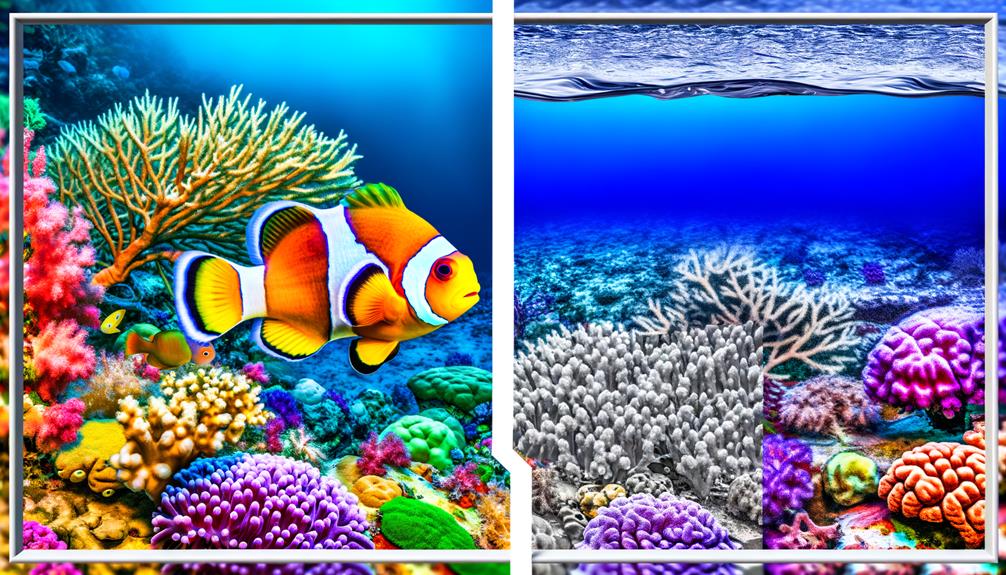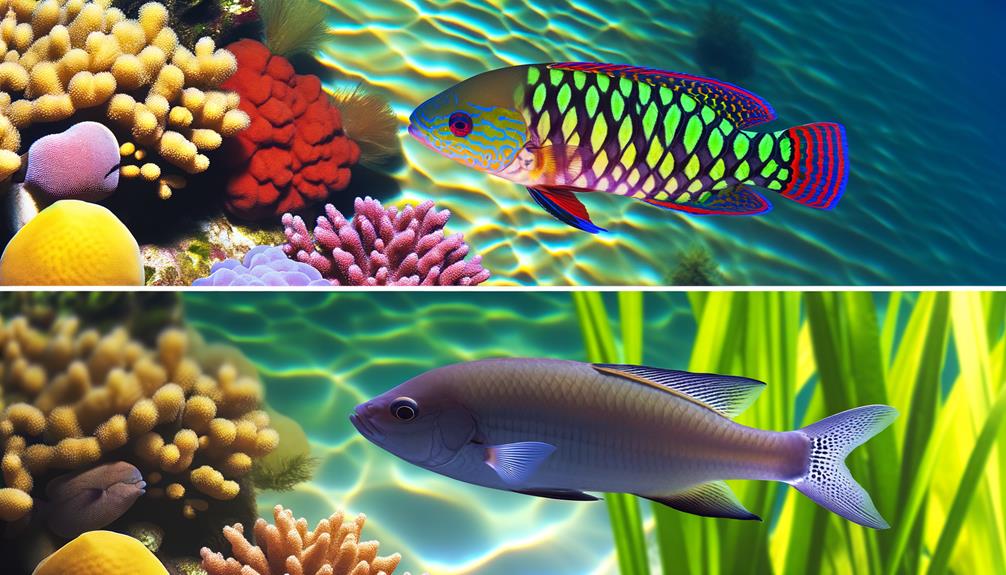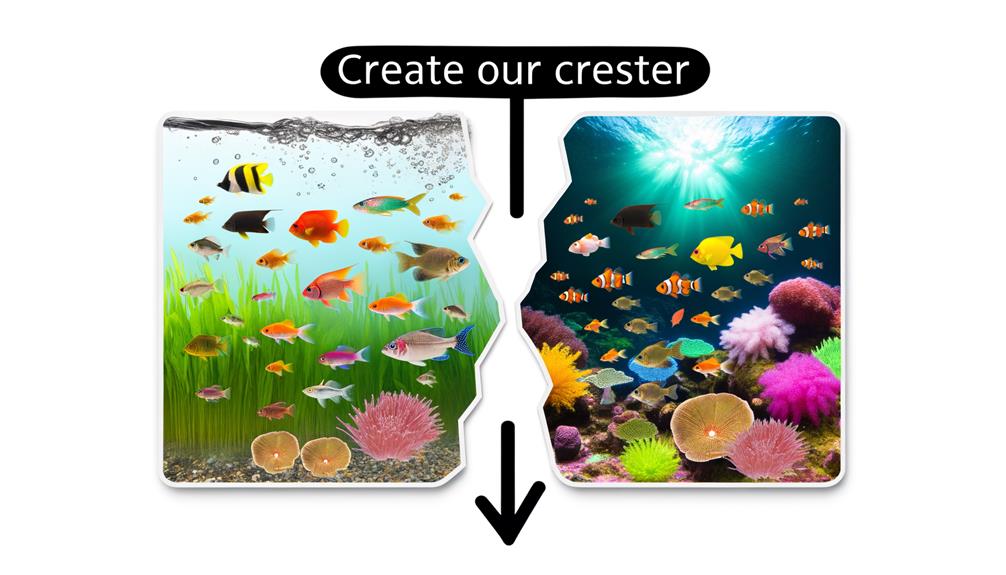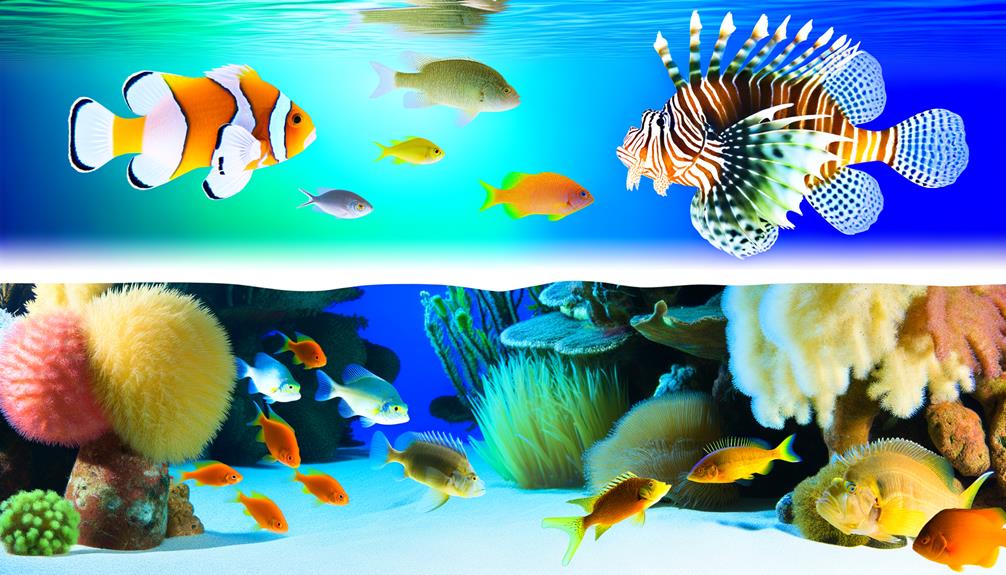The distinction between saltwater and freshwater fish not only resides in the ecosystems they inhabit but also in their unique physiological adaptations to these environments. These aquatic creatures have evolved in remarkable ways to survive and thrive in their specific habitats, whether it be the vast, saline ocean or the fresh, flowing rivers.
Their diet, size, and structural differences further delineate these two types of fish. While it's clear that their environments shape their characteristics and behaviors, one might wonder how these adaptations affect their survival when faced with rapidly changing ecosystems.
Key Takeaways
- Freshwater and saltwater fish differ in habitats, with unique adaptations for survival in low and high saline environments respectively.
- Freshwater fish species like catfish and trout contrast with saltwater species such as bass and marlin in diversity and behavioral traits.
- Physiological differences include freshwater fish's specialized gills and efficient kidneys for osmoregulation, while saltwater fish have streamlined bodies for efficient swimming.
- Freshwater fish like salmon have higher levels of certain nutrients compared to saltwater fish, influencing their dietary value and flavor.
Defining Saltwater Fish
While saltwater fish, originating from the ocean, demonstrate a remarkable ability to thrive in stable environments through osmosis, their survival hinges on specialized physiological adaptations that allow them to maintain osmotic balance in their bodies. This complex process, known as osmoregulation, is a vital function that aids in the preservation of life in typically inhospitable marine environments.
Saltwater fish species, such as the Mahi-Mahi, flourish in a variety of habitats, including coral reefs and deep-sea regions. Their resilient bodies are adept at replacing lost water with saltwater, highlighting their adaptability and resourcefulness. This balance between water and salt is a masterful example of evolutionary survival strategies, a testament to the robustness of these marine creatures.
Ideal saltwater habitats such as coral reefs and mangroves provide these fish with a balanced ecosystem, abundant in both food and protective cover. Here, they achieve a harmonious coexistence with fellow marine life, contributing to the diverse and vibrant biodiversity of our oceans.
Characteristics of Freshwater Fish
Contrasting their saltwater counterparts, freshwater fish, primarily inhabitants of rivers and lakes, exhibit an impressive ability to adapt to fluctuating conditions of their environment. Unlike their saltwater brethren, these species reside in regions with lower salinity levels, leading to a unique physiological trait: the retention and absorption of salt.
The biological design of freshwater fish is a marvel in itself. Equipped with a set of highly efficient gills, these creatures perform an exquisite filtration process, preventing impurities from entering their bodies, thus maintaining their internal health. Additionally, they possess large and proficient kidneys, a vital organ that enables them to process and handle the abundant water in their habitats effectively.
Species like trout and salmon showcase specialized adaptations, becoming quintessential examples of survival in freshwater habitats. These characteristics create a distinctive divide between freshwater and saltwater fish, emphasizing their ability to withstand and flourish in diverse ecological situations. Understanding these features allows us to appreciate the delicate balance of nature and to feel a sense of belonging to this interconnected ecosystem.
Survival: Saltwater Fish in Freshwater

In stark comparison to their freshwater counterparts, saltwater fish exhibit unique physiological traits designed for high salinity environments, which, paradoxically, become their downfall when exposed to freshwater conditions. Saltwater fish possess hypotonic cells that struggle to survive in the absence of high salt concentrations. The low salinity of freshwater environments causes water to enter their cells, disrupting their osmotic balance and initiating a chain of physiological catastrophes.
When saltwater fish are thrust into freshwater, they are unable to regulate the sudden influx of water due to their specialized salt-retaining mechanisms, causing their cells to swell and potentially burst. The rapid deterioration of their cellular structures leads to their ultimate demise, showcasing their acute vulnerability to changes in environmental salinity.
The survival of saltwater fish in freshwater is thus, unfortunately, a biological impossibility. Their intrinsic adaptation to high salt environments, while advantageous in their natural habitat, leaves them highly susceptible and ill-prepared for survival in freshwater conditions. This highlights the remarkable specificity of physiological adaptations and the delicate balance of life in the diverse aquatic biospheres.
Freshwater Fish in Saltwater: Possible?
The potential survival of freshwater fish in saltwater necessitates an examination of osmoregulation challenges. The key issue for freshwater fish is their inability to effectively osmoregulate in high saline environments, leading to a state of dehydration.
The effect of saltwater on these fish, possible survival rates, and adaptations are crucial aspects to consider. A detailed exploration of these physiological constraints and any evolutionary adaptations that may permit survival in such environments, albeit rare, forms the basis of this discussion.
Osmoregulation Challenges for Fish
Navigating the complex waters of osmoregulation, freshwater fish confront significant challenges when exposed to saltwater, primarily due to the hypotonic nature of their cells. In an environment where salt is prevalent, these fish struggle to maintain balance in their bodily functions, resulting in severe dehydration and eventual death. This is due to the excessive intake of salt, which disrupts the osmoregulatory process. For survival, freshwater fish rely on lower salt concentrations, unlike their saltwater counterparts who thrive in higher saline conditions.
| Freshwater Fish | Saltwater Fish |
|---|---|
| Hypotonic cells | Hypertonic cells |
| Lower salt concentrations | Higher salt concentrations |
| Risk of dehydration in saltwater | Thrive in saltwater |
| Osmoregulation challenges in saltwater | Efficient osmoregulation in saltwater |
Understanding these challenges provides critical insights into the survival mechanisms of different fish species in diverse aquatic environments.
Saltwater's Effect on Freshwater Fish
Building upon the osmoregulatory challenges freshwater fish face in saltwater environments, we now turn our attention to the specific physiological impacts of saltwater on these species and the potential feasibility of their survival in such conditions.
- Freshwater fish maintain salt concentrations in their cells higher than that of their surrounding environment. However, in saltwater, the reverse situation occurs, leading to potential dehydration.
- The hypotonic cells of saltwater fish, when exposed to freshwater, result in an osmotic imbalance due to the lack of necessary salt content.
- The inability of freshwater fish to osmoregulate in a saltwater environment is largely due to their physiological adaptations to freshwater habitats.
- Saltwater's effect on freshwater fish is profound, often leading to death due to their inability to adjust to the high salinity.
Survival Rates and Adaptations
Invariably, the survival rates of freshwater fish in saltwater environments are significantly low, primarily due to their physiological inability to maintain higher salt concentrations in their bodies. As they lack the osmoregulatory adaptations of saltwater fish, dehydration ensues when exposed to saltwater, leading to a rapid decline in survival.
The following table illustrates key differences:
| Freshwater Fish | Saltwater Fish |
|---|---|
| Unable to maintain high salt concentrations | Adapted to high salt concentrations |
| Saltwater exposure leads to dehydration | Osmosis helps replace lost water |
| Mismatch in salt concentration leads to death | Thrive in their native salty environment |
Understanding these inherent limitations and adaptations of freshwater fish and saltwater fish allows us to appreciate the delicate balance of life within our diverse aquatic ecosystems.
Dietary Impact of Fish Types
The dietary profiles of both saltwater and freshwater fish offer a wealth of nutrients, albeit with some notable variances due to their distinct habitats and biological adaptations. For instance, saltwater fish, influenced by their marine habitat, exhibit a saltier flavor, while freshwater fish possess a milder taste due to their less saline environment. This flavor distinction is integral to the sensory appreciation of fish and can significantly impact personal dietary choices.
- Freshwater fish, such as salmon, are noteworthy for their higher levels of beneficial fatty acids, calcium, folate, and vitamin A, compared to their saltwater counterparts. These nutrients are vital for maintaining optimal body functions and fluid balance.
- Despite the nutritional discrepancies, both fish types are healthy food choices given their similar sodium content. This makes them suitable for a wide variety of diets, particularly for individuals monitoring their salt intake.
- Freshwater fish inhabit lakes and rivers, unique ecosystems that influence their individual flavor profiles and nutrient composition.
- When deciding between saltwater and freshwater fish, considering one's taste preferences, the fish's bone structures, nutrient variances, and the respective ecosystem differences can offer a more enriching dining experience.
In essence, an understanding of these dietary impacts can foster a sense of belonging among consumers by aligning their dietary choices with their personal health goals and culinary preferences.
Understanding Fish Physiology

In understanding fish physiology, it's essential to grasp the mechanics of osmoregulation, the process by which fish maintain water balance in their bodies.
This physiological function varies significantly between saltwater and freshwater species, shaping their unique survival strategies and adaptations.
The subsequent analysis will focus on the osmoregulation process, how it differs in saltwater and freshwater habitats, and its consequent impact on fish survival.
Fish Osmoregulation Process
Navigating the intricate process of osmoregulation, both saltwater and freshwater fish have evolved distinct mechanisms to maintain their internal balance while facing starkly different aquatic environments. They skillfully exploit osmosis to their advantage, despite the contrasting water conditions.
Saltwater Fish: These species replace lost water by consuming saltwater. Thus, they manage to maintain internal hydration despite their hypertonic surroundings.
Freshwater Fish: They retain and absorb salt while in water with minimal dissolved salt, maintaining their internal salt concentration.
Osmosis in Saltwater Fish: This process leads to the loss of body fluids through gills, requiring the intake of saline water for equilibrium.
Osmosis in Freshwater Fish: Their gills are designed to prevent impurities from entering, while their kidneys efficiently process water, achieving osmoregulation.
Saltwater Vs Freshwater Adaptations
Diving into the realm of fish physiology, we uncover the intricate adaptations that allow both saltwater and freshwater fish to survive and thrive in their distinct aquatic environments. Saltwater fish are hypertonic to the surrounding saline ocean, replacing lost water by consuming saltwater. Osmosis drives fluid loss through their gills, necessitating water intake for equilibrium.
Conversely, freshwater fish have adapted to retain and absorb salt in less saline rivers and lakes. Their large, efficient kidneys purify water, barring impurities. Oxygen extraction is another adaptation; freshwater fish extract from less oxygenated water, while saltwater fish employ efficient oxygen exchange mechanisms.
These physiological differences demonstrate the remarkable adaptive strategies of these aquatic species, facilitating their survival in diverse habitats.
Impact on Fish Survival
Understanding the intricacies of fish physiology, particularly the distinctive features of their gills and kidneys, is crucial in comprehending how freshwater and saltwater fish adapt and survive in their respective environments.
Let's delve into these critical physiological adaptations:
- Freshwater fish possess specialized gills that prevent harmful substances from infiltrating their bodies, maintaining an internal equilibrium.
- Conversely, saltwater fish continuously lose bodily fluids through their gills due to the process of osmosis, thereby facing a constant struggle against dehydration.
- To counter this, saltwater fish consume seawater and excrete excess salts through their gills and kidneys.
- On the other hand, freshwater fish have large, efficient kidneys that eliminate excess water, helping them adapt to environments with less than 0.5 parts per thousand of dissolved salt.
Thus, these adaptations are vital for the survival of both saltwater and freshwater fish.
Habitats: Freshwater Vs Saltwater

In exploring the diverse realms of aquatic life, it becomes imperative to distinguish between the habitats of freshwater and saltwater fish, each characterized by unique salinity levels, ecological adaptations, and survival mechanisms.
Freshwater fish, often found in rivers and lakes, swim in environments with salinity levels around 0.5 parts per thousand. Adaptability is a cornerstone of their survival, enabling them to adjust swiftly to changing environments. Their physiology also allows them to retain and absorb salt, maintaining a crucial balance in their low-salinity habitats.
On the other hand, saltwater fish originate from oceanic environments, which have significantly higher salinity levels. Unlike their freshwater counterparts, they thrive in more stable habitats. Their survival hinges on osmotic regulation, replacing lost water with saltwater to sustain equilibrium. Species like the Mahi-Mahi are emblematic of the saltwater fish group, exhibiting a remarkable adaptation to specific oceanic environments such as coral reefs.
Thus, the differing habitats of freshwater and saltwater fish, marked by unique salinity levels and survival strategies, reflect the incredible diversity and adaptability of aquatic life.
Size and Structural Differences
Moving beyond habitats, the size and structural differences between freshwater and saltwater fish further underscore their distinct evolutionary paths and environmental adaptations.
- Freshwater fish vary in size, from the minute Philippine gobies to the colossal white sturgeons. The largest freshwater fish on record is the white sturgeon, which can reach a whopping 400 pounds.
- In contrast, the smallest saltwater fish is the diminutive Marshall Islands goby fish. However, the oceans are home to the largest fish in existence – the whale shark, which averages a remarkable 12.5 meters in length.
- The weight of saltwater fish can surpass that of freshwater species. For instance, saltwater species like tuna and marlin can tip the scales at over 21.5 tons.
- These size and weight differences between freshwater and saltwater species are a testament to their unique adaptations to their habitats.
The diversity in size and structure among freshwater and saltwater fish demonstrates the exciting breadth of life in aquatic ecosystems. Their adaptations, resulting in different sizes and structures, are testament to the remarkable capacity of fish to evolve and thrive in a variety of environments.
Diverse Examples of Fish Species

Building upon the knowledge of size and adaptation, it is worthwhile to examine the diversity of species within freshwater and saltwater fish, each boasting a unique set of traits perfectly suited to their respective habitats.
Freshwater fish, such as catfish, trout, pike, and salmon, are commonly found in rivers and lakes. These species are adapted to environments with low salt content. Variants like sunfish and whitefish are also prevalent in these freshwater environments.
On the other hand, saltwater fish, including bass, eels, cod, shark, and tuna, typically inhabit oceans and seas. They are built to survive in high saline conditions. Marlin and snapper are also examples of saltwater fish, demonstrating a broad range of species within this category.
To visualize the diversity, consider the following table:
| Habitat | Fish Species | Common Environment |
|---|---|---|
| Freshwater | Catfish | Rivers and Lakes |
| Freshwater | Trout | Rivers and Lakes |
| Saltwater | Bass | Oceans and Seas |
| Saltwater | Eels | Oceans and Seas |
| Saltwater | Marlin | Oceans and Seas |
This table encapsulates the extensive diversity and unique characteristics of both freshwater and saltwater fish.
Frequently Asked Questions
Can Salt Water Fish Live in Freshwater?
Saltwater fish cannot live in freshwater due to osmoregulation challenges. Their cells are hypotonic, leading to fatal water intake. This highlights fish adaptation mechanisms necessary for survival in their specific salinity environments.
What Is the Difference Between Salt Water and Fresh Water Fishing?
Saltwater and freshwater fishing significantly differ in terms of gear and fishing techniques utilized. Would you reel in a marlin with the same gear as a trout? Absolutely not. Environments, target species, and equipment all vary.
What Is the Difference Between Freshwater and Saltwater Catfish?
Freshwater and saltwater catfish differ primarily in their adaptations to their environments. Freshwater catfish use whisker-like barbels for navigation, while saltwater species tolerate fluctuating salinity levels. Their diets also vary based on available food sources.
Are Saltwater Fish More Aggressive Than Freshwater?
Aggression in fish, whether saltwater or freshwater, is not solely determined by their environment. Factors like species, habitat, and food availability play key roles. Predatory behaviors and aggression triggers can differ significantly among individual species.
Conclusion
In conclusion, the dichotomy between saltwater and freshwater fish highlights the remarkable adaptability of piscine species to their environment. These differences, manifesting in habitat, diet, physiology, and structural characteristics, are fundamentally driven by osmotic mechanisms.
Hence, it is clear that the survival and evolution of these diverse species are innately tied to their osmotic adaptations – a testament to the compelling force of nature in shaping life's diversity.


